Turkic peoples
 The countries and autonomous regions where a Turkic language has official status and/or is spoken by a majority. | |
| Total population | |
|---|---|
| Approximately 150–200 million[1][2] speak a Turkic language | |
| Regions with significant populations | |
| 55,000,000+ (over 80% of total country pop.)[3] | |
| 26,000,000 (92% of total country pop.) | |
|
c. 14,000,000-15,000,000 (18% of the population) speak Azeri Turkish and other Turkic dialects [4] | |
| 12,009,969 (8.41% of total country pop.)[5] | |
| 12,000,000 (75% of total country pop.) | |
| 11,647,000 (0.8% of the total country pop.) | |
| 9,047,000 (96.7% of total country pop.) | |
| 5,210,000 | |
| 4,500,000[6] (90% of the total country pop.) | |
| 4,500,000 (90% of the total country pop.) | |
| 3,500,000[7] (15% of total country pop.) | |
| 1,500,000 (5% of the total country pop.) | |
| 1,200,000 (20% of the total country pop.) | |
| more than 1,000,000[8] | |
| 600,000-800,000 | |
| 298,862 | |
| 293,500 | |
| 275,300[9] | |
| 224,460 | |
| 178,000 h | |
| 158,300 | |
| 77,959 | |
| Languages | |
| Turkic languages | |
| Religion | |
|
Islam (mainly Sunni with Alevi and Shia minorities) Christianity (mainly Orthodox Christianity) Judaism (mainly Djudios Turkos with minorities of Sabbataists and Karaites) Tengrism, Shamanism, and irreligion (agnosticism and atheism), Animism, historically Buddhism | |
The Turkic peoples are a collection of ethnic groups that live in northern, eastern, central, and western Asia, northwestern China, and parts of eastern Europe. They speak languages belonging to the Turkic language family.[10] They share, to varying degrees, certain cultural traits and historical backgrounds. The term Turkic represents a broad ethno-linguistic group of peoples including existing societies such as the Turkish people, Azerbaijanis, Chuvashes, Kazakhs, Tatars, Kyrgyz, Turkmens, Uyghurs, Uzbeks, Bashkirs, Qashqai, Gagauz, Yakuts, Crimean Karaites, Krymchaks, Karakalpaks, Karachays, Balkars, Nogais and as well as past civilizations such as the Göktürks, Kumans, Kipchaks, Avars, Bulgars, Turgeshes, Khazars, Seljuk Turks, Ottoman Turks, Mamluks, Timurids, Khiljis, and possibly Huns and the Xiongnu.[10][11][12]
Name etymology
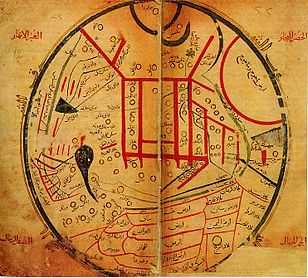
The first known mention of the term Turk (Old Turkic: ![]()
![]()
![]()
![]() Türük[13][14] or
Türük[13][14] or ![]()
![]()
![]()
![]()
![]()
![]()
![]() Kök Türük[13][14] or
Kök Türük[13][14] or ![]()
![]()
![]()
![]() Türük,[15] Chinese: 突厥, Pinyin: Tūjué, Middle Chinese (Guangyun): [tʰuot-küot]) applied to a Turkic group was in reference to the Göktürks in the 6th century. A letter by Ishbara Qaghan to Emperor Wen of Sui in 585 described him as "the Great Turk Khan."[16] The Orhun inscriptions (735 CE) use the terms Turk and Turuk.
Türük,[15] Chinese: 突厥, Pinyin: Tūjué, Middle Chinese (Guangyun): [tʰuot-küot]) applied to a Turkic group was in reference to the Göktürks in the 6th century. A letter by Ishbara Qaghan to Emperor Wen of Sui in 585 described him as "the Great Turk Khan."[16] The Orhun inscriptions (735 CE) use the terms Turk and Turuk.
Previous use of similar terms are of unknown significance, although some strongly feel that they are evidence of the historical continuity of the term and the people as a linguistic unit since early times. This includes Chinese records Spring and Autumn Annals referring to a neighbouring people as Beidi.[17]
There are references to certain groups in antiquity whose names could be the original form of "Türk/Türük" such as Togarma, Turukha, Turukku and so on. But the information gap is so substantial that we cannot firmly connect these ancient people to the modern Turks.[18][19][20] According to the assumptions of the Turkologists Peter Golden and András Róna-Tas, the term Turk could be rooted in the East Iranian Saka language.[21] However, it is generally accepted that the term "Türk" is ultimately derived from the Old-Turkic migration-term[22] "Türük" or "Törük",[23] which means "created", "born",[24] or "strong".[25]
The Chinese Book of Zhou (7th century) presents an etymology of the name Turk as derived from "helmet", explaining that taken this name refers to the shape of the Altai Mountains.[citation needed] According to Persian tradition, as reported by 11th-century ethnographer Mahmud of Kashgar and various other traditional Islamic scholars and historians, the name "Turk" stems from Tur, one of the sons of Japheth (see Turan). During the Middle Ages, the various Turkic peoples of the Eurasian steppe were also subsumed under the classical name of the Scythians.[26] Between 400 CE and the 16th century the Byzantine sources use the name Σκΰθαι in reference to twelve different Turkic peoples.[26]
In the modern Turkish language as used in the Republic of Turkey, a distinction is made between "Turks" and the "Turkic peoples" in loosely speaking: the term Türk corresponds specifically to the "Turkish-speaking" people (in this context, "Turkish-speaking" is considered the same as "Turkic-speaking"), while the term Türki refers generally to the people of modern "Turkic Republics" (Türki Cumhuriyetler or Türk Cumhuriyetleri). However, the proper usage of the term is based on the linguistic classification in order to avoid any political sense. In short, the term Türki can be used for Türk or vice versa.[27]
History
Origins and early expansion
 Pre-14th century | |||||||
|---|---|---|---|---|---|---|---|
| Turkic Khaganate 552–744 | |||||||
| Western Turkic | |||||||
| Eastern Turkic | |||||||
| Avar Khaganate 564–804 | |||||||
| Khazar Khaganate 618–1048 | |||||||
| Old Great Bulgaria 632–668 | |||||||
| Volga Bulgaria | |||||||
| Turgesh Khaganate 699–766 | |||||||
| Uyghur Khaganate 744–840 | |||||||
| Kara-Khanid Khanate 840–1212 | |||||||
| Western Kara-Khanid | |||||||
| Eastern Kara-Khanid | |||||||
| Pecheneg Khanates 860–1091 |
Kimek Khanate 743–1035 | ||||||
| Kipchak Khanates 1067–1239 |
Oghuz Yabgu State 750–1055 | ||||||
| Shatuo Dynasties 923–979 | |||||||
| Later Tang Dynasty | |||||||
| Later Jin Dynasty | |||||||
| Later Han Dynasty (Northern Han) | |||||||
| Ghaznavid Empire 963–1186 | |||||||
| Seljuq Empire 1037–1194 | |||||||
| Khwarazmian Dynasty 1077–1231 | |||||||
| Seljuq Sultanate of Rum 1092–1307 | |||||||
| Delhi Sultanate 1206–1526 | |||||||
| Mamluk Dynasty | |||||||
| Khilji Dynasty | |||||||
| Tughlaq Dynasty | |||||||
| Cairo Sultanate 1250–1517 | |||||||
| Bahri Dynasty | |||||||
|
Other Turkic Dynasties
in Anatolia | |||||||

It is generally agreed that the first Turkic people lived in a region extending from Central Asia to Siberia with the majority of them living in China historically. Historically they were established after the 6th century BCE.[28] The earliest separate Turkic peoples appeared on the peripheries of the late Xiongnu confederation (contemporaneous with the Chinese Han Dynasty).[29] Turkic people may be related to the Xiongnu, Dingling and Tiele people. According to the Book of Wei, the Tiele people were the remaining of the Chidi (赤狄), the red Di people competing with the Jin in the Spring and Autumn Period.[30] Turkic tribes, such as Khazars and Pechenegs, probably lived as nomads for many years before establishing the Göktürk Empire or Mongolia in the 6th century. These were herdsmen and nobles who were searching for new pastures and wealth. The first mention of Turks was in a Chinese text that mentioned trade of Turk tribes with the Sogdians along the Silk Road.[31] The first recorded use of "Turk" as a political name is a 6th-century reference to the word pronounced in Modern Chinese as Tujue. The Ashina clan migrated from Li-jien (modern Zhelai Zhai) to the Juan Juan seeking inclusion in their confederacy and protection from the prevalent dynasty. The tribe were famed metal smiths and was granted land near a mountain quarry which looked like a helmet, from which they were said to have gotten their name 突厥 (tūjué). A century later, their power had increased such that they conquered the Juan Juan and established the Gök Empire.[32]
Turkic peoples originally used their own alphabets, like Orkhon and Yenisey runiform, and later the Uyghur alphabet. Traditional national and cultural symbols of the Turkic peoples include wolves in Turkic mythology and tradition; as well as the color blue, iron, and fire. Turquoise blue, from the French word meaning "Turkish", is the color of the stone turquoise still used as jewelry and a protection against evil eye.
It has often been suggested that the Xiongnu, mentioned in Han Dynasty records, were Proto-Turkic speakers.[33][34][35][36][37] Although little is known for certain about the Xiongnu language(s), it seems likely that at least some Xiongnu tribes spoke a Turkic language.[38] Some scholars see a possible connection with the Iranian-speaking Sakas,[39] while others believe they were probably a confederation of various ethnic and linguistic groups. On the other hand, genetics research from 2003[40] confirms the studies indicating that the Turkic people originated from the same area and so are related with the Xiongnu.[41]
Xiongnu writing, older than Turkic is agreed to have the earliest known Turkic alphabet, the Orkhon script. This has been argued recently using the only extant possibly Xiongu writings, the rock art of the Yinshan and Helanshan.[42] It is dated from the 9th millennium BCE to 19th century, and consists mainly of engraved signs (petroglyphs) and few painted images.[43] Excavations done during 1924–1925, in Noin-Ula kurgans located in Selenga River in the northern Mongolian hills north of Ulan Bator, produced objects with over 20 carved characters, which were either identical or very similar to that of to the runic letters of the Turkic Orkhon script discovered in the Orkhon Valley.[44]
The Hun hordes of Attila, who invaded and conquered much of Europe in the 5th century, might have been Turkic and descendants of the Xiongnu.[29][45][46] Some scholars argue that the Huns were one of the earlier Turkic tribes, while others argue that they were of Mongolic origin.[47] Linguistic studies by Otto Maenchen-Helfen suggest that while many Hun proper names may have been Turkic in origin,[48][49] the language used by the Huns in Europe was too little documented to be classified, and was more likely an Indo-European language. In the first half of the first millennium, mass migrations to distant places were common, geographical borders were fluid and cultural identity was more likely to change dramatically in the lifetime of an individual, relative to the modern era. These factors also made it more likely that the Huns were, initially at least, closely related to the Turkic peoples.
In the 6th century, 400 years after the collapse of northern Xiongnu power in Inner Asia, leadership of the Turkic peoples was taken over by the Göktürks. Formerly in the Xiongnu nomadic confederation, the Göktürks inherited their traditions and administrative experience. From 552 to 745, Göktürk leadership united the nomadic Turkic tribes into the Göktürk Empire. This was the first known political entity to be called "Turk". The name derives from gok, "blue" or "celestial". Unlike its Xiongnu predecessor, the Göktürk Khanate had its temporary khans from the Ashina clan that were subordinate to a sovereign authority controlled by a council of tribal chiefs. The Khanate retained elements of its original shamanistic religion, Tengriism, although it received missionaries of Buddhist monks and practiced a syncretic religion. The Göktürks were the first Turkic people to write Old Turkic in a runic script, the Orkhon script. The Khanate was also the first state known as "Turk". It eventually collapsed due to a series of dynastic conflicts, but the name "Turk" was later taken by many states and peoples.
Turkic peoples and related groups migrated west from Turkestan and what is now Mongolia towards Eastern Europe, Iranian plateau and Anatolia and modern Turkey in many waves.[50] The date of the initial expansion remains unknown. After many battles, they established their own state and later created the Ottoman Empire.[51] The main migration occurred in medieval times, when they spread across most of Asia and into Europe and the Middle East.[32] They also participated in the Crusades.[52]
_tr.png)
Later Turkic peoples include the Avars, Karluks (mainly 8th century), Uyghurs, Kyrgyz, Oghuz (or Ğuz) Turks, and Turkmens. As these peoples were founding states in the area between Mongolia and Transoxiana, they came into contact with Muslims, and most gradually adopted Islam. Small groups of Turkic people practice other religions, including Christians, Jews (Khazars), Buddhists, and Zoroastrians.

Middle Ages
Turkic soldiers in the army of the Abbasid caliphs emerged as the de facto rulers of most of the Muslim Middle East (apart from Syria and Egypt), particularly after the 10th century. The Oghuz and other tribes captured and dominated various countries under the leadership of the Seljuk dynasty and eventually captured the territories of the Abbasid dynasty and the Byzantine Empire.[32]
Meanwhile, the Kyrgyz and Uyghurs were struggling with one another and with the Chinese Empire. The Kyrgyz people ultimately settled in the region now referred to as Kyrgyzstan. The Bulgars established themselves in between the Caspian and Black Seas in the 5th and 6th centuries, followed by their conquerors, the Khazars who converted to Judaism in the 8th or 9th century. After them came the Pechenegs who created a large confederacy, which was subsequently taken over by the Cumans and the Kipchaks. One group of Bulgars settled in the Volga region and mixed with local Volga Finns to become the Volga Bulgars in what is today Tatarstan. These Bulgars were conquered by the Mongols following their westward sweep under Genghis Khan in the 13th century. Other Bulgars settled in Southeastern Europe in the 7th and 8th centuries, and mixed with the Slavic population, adopting what eventually became the Slavic Bulgarian language. Everywhere, Turkic groups mixed with the local populations to varying degrees.[32] In 1090–91, the Turkic Pechenegs reached the walls of Constantinople, where Emperor Alexius I with the aid of the Kipchaks annihilated their army.[53]
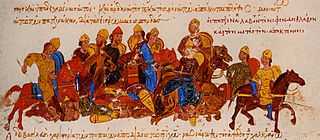
Islamic empires

As the Seljuk Empire declined following the Mongol invasion, the Ottoman Empire emerged as the new important Turkic state, that came to dominate not only the Middle East, but even southeastern Europe, parts of southwestern Russia, and northern Africa.[32]
The Delhi Sultanate is a term used to cover five short-lived, Delhi-based kingdoms three of which were of Turkic origin in medieval India. These Turkic dynasties were the Mamluk dynasty (1206–90); the Khilji dynasty (1290–1320); and the Tughlaq dynasty (1320–1414). Southern India, also saw many Turkic origin dynasties like Adil Shahi dynasty, Bidar Sultanate, Ahmadnagar Sultanate, Qutb Shahi dynasty, collectively known as Deccan sultanates.

In Eastern Europe, Volga Bulgaria became an Islamic state in 922 and influenced the region as it controlled many trade routes. In the 13th century, Mongols invaded Europe and established the Golden Horde in Eastern Europe, western & northern Central Asia, and even western Siberia. The Cuman-Kipchak Confederation and Islamic Volga Bulgaria were absorbed by the Golden Horde in the 13th century; in the 14th century, Islam became the official religion under Uzbeg Khan where the general population (Turks) as well as the aristocracy (Mongols) came to speak the Kipchak language and were collectively known as "Tatars" by Russians and Westerners. This country was also known as the Kipchak Khanate and covered most of what is today Ukraine, as well as the entirety of modern-day southern and eastern Russia (the European section). The Golden Horde disintegrated into several khanates and hordes in the 15th and 16th century including the Crimean Khanate, Khanate of Kazan, and Kazakh Khanate (among others), which were one by one conquered and annexed by the Russian Empire in the 16th through 19th centuries.

In Siberia, the Siberian Khanate was established in the 1490s by fleeing Tatar aristocrats of the disintegrating Golden Horde who established Islam as the official religion in western Siberia over the partly Islamized native Siberian Tatars and indigenous Uralic peoples. It was the northern-most Islamic state in recorded history and it survived up until 1598 when it was conquered by Russia.
The Chagatai Khanate was the eastern & southern Central Asian section of the Mongol Empire in what is today part or whole of Tajikistan, Afghanistan, Turkmenistan, Kazakhstan, Uzbekistan, Kyrgyzstan, and Xinjiang ("Uyghurstan"). Like the Ilkhanate and Golden Horde, the Chagatai Khanate became a Muslim state in the 14th century.
The Timurid Empire were an Turkic Uzbek-based empire founded in the late 14th century by Timurlane, a descendant of Genghis Khan. Timur, although a self-proclaimed devout Muslim, brought great slaughter in his conquest of fellow Muslims in neighboring Islamic territory and contributed to the ultimate demise of many Muslim states, including the Golden Horde.
The Mughal Empire was a Turkic-founded Indian empire that, at its greatest territorial extent, ruled most of the South Asia, including Afghanistan, Pakistan, India, Bangladesh and parts of Uzbekistan from the early 16th to the early 18th centuries. The Mughal dynasty was founded by a Chagatai Turkic prince named Babur (reigned 1526–30), who was descended from the Turkic conqueror Timur (Tamerlane) on his father's side and from Chagatai, second son of the Mongol ruler Genghis Khan, on his mother's side.[54][55] A further distinction was the attempt of the Mughals to integrate Hindus and Muslims into a united Indian state.[54][56][57][58]
The Safavid dynasty of Persia, most probably of Azeri (Turkish) origin:[59][60][61] Through intermarriage and other political considerations, the Safavids spoke Persian and Turkish,[62][63] and some of the Shahs composed poems in their native Turkish language. Concurrently, the Shahs themselves also supported Persian literature, poetry and art projects including the grand Shahnama of Shah Tahmasp.[64][65] The Safavid dynasty ruled on the Greater Iran for more than two centuries.[66][67][68][69] and established the Twelver school of Shi'a Islam[70] as the official religion of their empire, marking one of the most important turning points in Muslim history
The Afsharid dynasty was named after the Turkic Afshar tribe to which they belonged. The Afshars had migrated from Turkestan to Azerbaijan in the 13th century. The dynasty was founded in 1736 by the military commander Nader Shah who deposed the last member of the Safavid dynasty and proclaimed himself King of Iran. Nader belonged to the Qereqlu branch of the Afshars.[71] During Nader's reign, Iran reached its greatest extent since the Sassanid Empire.
Modern history
The Ottoman Empire gradually grew weaker in the face of poor administration, repeated wars with Russia and Austro-Hungary, and the emergence of nationalist movements in the Balkans, and it finally gave way after World War I to the present-day Republic of Turkey.[32] Ethnic nationalism also developed in Ottoman Empire during the 19th century, taking the form of Pan-Turkism or Turanism.
The Turkic peoples of Central Asia were not organized in nation states during most of the 20th century, after the collapse of the Russian Empire living either in the Soviet Union or (after a short-lived First East Turkestan Republic) in the Chinese Republic.
In 1991, after the disintegration of the Soviet Union, five Turkic states gained their independence. These were Azerbaijan, Kazakhstan, Kyrgyzstan, Turkmenistan and Uzbekistan. Other Turkic regions such as Tatarstan, Tuva and Yakutia remained in the Russian Federation. Chinese Turkestan remained part of the People's Republic of China.
Immediately after the independence of the Turkic states, Turkey began seeking diplomatic relations with them. Over time political meetings increased and led to the establishment of TÜRKSOY in 1993 and later the Turkic Council in 2009.
Geographical distribution
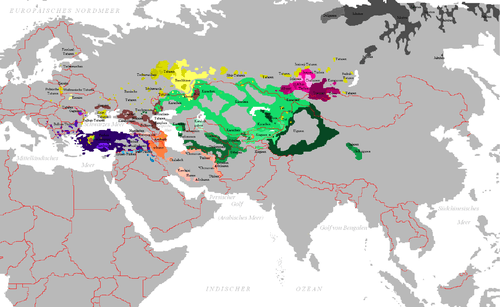

Many of the Turkic peoples have their homelands in Central Asia, where the Turkic peoples settled from China. According to historian John Foster, "The Turks emerge from among the Huns in the middle of [the] fifth century. They were living in Liang territory when it began to be overrun by the greater principality of Wei. Preferring to remain under the rule of their own kind, they moved westward into what is now the province of Kansu. This was the territory of kindred Huns, who were called the Rouran. The Turks were a small tribe of only five hundred families, and they became serfs to the Rouran, who used them as iron-workers. It is thought that the original meaning of "Turk" is "helmet", and that they may have taken this name because of the shape of one of the hills near which they worked. As their numbers and power grew, their chief made bold to ask for the hand of a Rouran princess in marriage. The demand was refused, and war followed. In 546, the iron-workers defeated their overlords."[72] Since then Turkic languages have spread, through migrations and conquests, to other locations including present-day Turkey. While the term "Turk" may refer to a member of any Turkic people, the term Turkish usually refers specifically to the people and language of the modern country of Turkey.
The Turkic languages constitute a language family of some 30 languages, spoken across a vast area from Eastern Europe and the Mediterranean, to Siberia and Western China, and through to the Middle East.
Some 170 million people have a Turkic language as their native language;[73] an additional 20 million people speak a Turkic language as a second language. The Turkic language with the greatest number of speakers is Turkish proper, or Anatolian Turkish, the speakers of which account for about 40% of all Turkic speakers.[74] More than one third of these are ethnic Turks of Turkey, dwelling predominantly in Turkey proper and formerly Ottoman-dominated areas of Eastern Europe and West Asia; as well as in Western Europe, Australia and the Americas as a result of immigration. The remainder of the Turkic people are concentrated in Central Asia, Russia, the Caucasus, China, and northern Iraq.
At present, there are six independent Turkic countries: Azerbaijan, Kazakhstan, Kyrgyzstan, Turkmenistan, Turkey, Uzbekistan; There are also several Turkic national subdivisions[75] in the Russian Federation including Bashkortostan, Tatarstan, Chuvashia, Khakassia, Tuva, Yakutia, the Altai Republic, Kabardino-Balkaria, and Karachayevo-Cherkessiya. Each of these subdivisions has its own flag, parliament, laws, and official state language (in addition to Russian).
The Xinjiang Uyghur Autonomous Region in western China and the autonomous region of Gagauzia, located within eastern Moldova and bordering Ukraine to the north, are two major autonomous Turkic regions. The Autonomous Republic of Crimea within Ukraine is a home of Crimean Tatars. In addition, there are several Iraq, Georgia, Bulgaria, the Republic of Macedonia, Tajikistan, Afghanistan, and western Mongolia.
The Turks in Turkey are over 60 million[76] to 70 million worldwide, while the second largest Turkic people are the Azerbaijanis, numbering 22 to 38 million worldwide; most of them live in Azerbaijan and Iran.
Turks in India are very small in number. There are barely 150 Turkish people from Turkey in India. These are recent immigrants. Descendants of Turkish rulers also exist in Northern India. Mughals who are part Turkic people also live in India in significant numbers. They are descendants of the Mughal rulers of India. Karlugh Turks are also found in small amounts in Srinagar region of Kashmir. Small amount of Uyghurs are also present in India. Turks also exist in Pakistan in similar proportions. One of the tribe in Hazara region of Pakistan is Karlugh Turks which is direct descendent of Turks of Central Asia. Turkish influence in Pakistan can be seen through the national language, Urdu, which comes from a Turkish word meaning "horde" or "army".
Western Yugur at Gansu in China, Salar at Qinghai in China, Dolgan at Krasnoyarsk Krai in Russia, Nogai at Dagestan in Russia are the Turk minorities at the respective regions. Beauty of Yugur Culture, Beauty of the Dolgan and Northern Tungus Culture, Beauty of Yakut Sakha Culture, Beauty of Khakass Culture at youtube show the facial feature of the Turks native to Asian Russia and China
International organizations
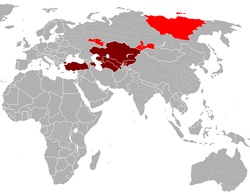
There are several international organizations created with the purpose of furthering cooperation between countries with Turkic-speaking populations, such as the Joint Administration of Turkic Arts and Culture (TÜRKSOY) and the Parliamentary Assembly of Turkic-speaking Countries (TÜRKPA).
The newly established Turkic Council, founded on November 3, 2009 by the Nakhchivan Agreement Mongolian confederation, Kazakhstan, Kyrgyzstan and Turkey, aims to integrate these organizations into a tighter geopolitical framework.
Demographics

The distribution of people of Turkic cultural background ranges from Siberia, across Central Asia, to Eastern Europe. As of 2011 the largest groups of Turkic people live throughout Central Asia—Kazakhstan, Kyrgyzstan, Turkmenistan, Uzbekistan, and Azerbaijan, in addition to Turkey and Iran. Additionally, Turkic people are found within Crimea, East Turkistan region of western China, northern Iraq, Israel, Russia, Afghanistan, and the Balkans: Moldova, Bulgaria, Romania, and former Yugoslavia. A small number of Turkic people also live in Vilnius, the capital of Lithuania. Small numbers inhabit eastern Poland and the south-eastern part of Finland.[77] There are also considerable populations of Turkic people (originating mostly from Turkey) in Germany, United States, and Australia, largely because of migrations during the 20th century.
Sometimes ethnographers group Turkic people into six branches: the Oghuz Turks, Kipchak, Karluk, Siberian, Chuvash, and Sakha/Yakut branches. The Oghuz have been termed Western Turks, while the remaining five, in such a classificatory scheme, are called Eastern Turks.
All the Turkic peoples native to Central Asia are of mixed Caucasoid and Mongoloid origin. The genetic distances between the different populations of Uzbeks scattered across Uzbekistan is no greater than the distance between many of them and the Karakalpaks. This suggests that Karakalpaks and Uzbeks have very similar origins. The Karakalpaks have a somewhat greater bias towards the eastern markers than the Uzbeks.[78]
Historical population:
| Year | Population |
|---|---|
| 1 AD | 2-2,5 million? |
| 2013 | 150-200 million |
The Turkic people display a great variety of ethnic types.[79] They possess physical features ranging from Caucasoid to Northern Mongoloid. Mongoloid and Caucasoid facial structure is common among many Turkic groups, such as Chuvash people, Tatars, Kazakhs, Uzbeks, Hazaras, and Bashkirs. Historically, the racial classification of the Turkic peoples was sometimes given as "Turanid".
The following incomplete list of Turkic people shows the respective groups' core areas of settlement and their estimated sizes (in millions):
| People | Region | Population | Modern language | Predominant religion |
|---|---|---|---|---|
Turkish people
|
Turkey, Germany, Algeria, Iraq, Bulgaria, Georgia, Syria, Yugoslavia, Greece | 70 M | Turkish | Sunni Islam and Alevism |
| Azerbaijanis | Azerbaijan Republic, Iran, Iraq, Turkey, Russia, Georgia | 30 M | Azerbaijani | Shia Islam |
| Uzbeks | Uzbekistan, Afghanistan, Tajikistan, Kazakhstan, Kyrgyzstan, Turkmenistan | 28,3 M | Uzbek | Sunni Islam |
| Kazakhs | Kazakhstan, Russia, China, Uzbekistan | 13.8 M | Kazakh | Sunni Islam |
| Uyghurs | China (Xinjiang), Kazakhstan, Uzbekistan, Kyrgyzstan, Turkey | 9 M | Uyghur | Sunni Islam |
| Turkmens | Turkmenistan, Iran, Afghanistan, | 8 M | Turkmen | Sunni Islam |
| Tatars | Russia, Uzbekistan, Kazakhstan, Tajikistan, Poland, Lithuania, Finland | 7 M | Tatar | Sunni Islam |
| Kyrgyzs | Kyrgyzstan, Afghanistan, Uzbekistan, China, Tajikistan | 4,5 M | Kyrgyz | Sunni Islam |
| Bashkirs | Russia, Uzbekistan, Kazakhstan | 2 M | Bashkir | Sunni Islam |
| Crimean Tatars | Ukraine (Crimea), Russia, Uzbekistan, Turkey, Romania | 0.5 to 2 M | Crimean Tatar | Sunni Islam |
| Qashqai | Iran | 1.7 M | Qashqai | Shia Islam |
| Chuvashes | Russia | 1.7 M | Chuvash | Orthodox Christianity |
| Karakalpaks | Uzbekistan, Kazakhstan, Turkmenistan | 0.6 M | Karakalpak | Sunni Islam |
| Yakuts | Russia | 0.5 M | Sakha | Orthodox Christianity |
| Kumyks | Russia | 0.4 M | Kumyk | Sunni Islam |
| Karachays and Balkars | Russia, Turkey | 0.4 M | Karachay-Balkar | Sunni Islam |
| Tuvans | Russia | 0.3 M | Tuvan | Tibetan Buddhism |
| Gagauzs | Moldova, Greece | 0.2 M | Gagauz | Orthodox Christianity |
| Turkic Karaites and Krymchaks | Lithuania, Poland, Russia, Turkey | 0.2 M | Karaim and Krymchak | Judaism |
Language



The Turkic alphabets are sets of related alphabets with letters (formerly known as runes), used for writing mostly Turkic languages. Inscriptions in Turkic alphabets were found from Mongolia and Eastern Turkestan in the east to Balkans in the west. Most of the preserved inscriptions were dated to between 8th and 10th centuries CE.
The earliest positively dated and read Turkic inscriptions date from c. 150, and the alphabets were generally replaced by the Uyghur alphabet in the Central Asia, Arabic script in the Middle and Western Asia, Greek-derived Cyrillic in Eastern Europe and in the Balkans, and Latin alphabet in Central Europe. The latest recorded use of Turkic alphabet was recorded in Central Europe's Hungary in 1699 CE.
The Turkic runiform scripts, unlike other typologically close scripts of the world, do not have a uniform palaeography as, for example, have the Gothic runes, noted for the exceptional uniformity of its language and paleography.[80] The Turkic alphabets are divided into four groups, the best known of them is the Orkhon version of the Enisei group. The Orkhon script is the alphabet used by the Göktürks from the 8th century to record the Old Turkic language. It was later used by the Uyghur Empire; a Yenisei variant is known from 9th-century Kyrgyz inscriptions, and it has likely cousins in the Talas Valley of Turkestan and the Old Hungarian script of the 10th century.
The Turkic language family is traditionally considered to be part of the proposed Altaic language family.[74][81][82][83] The Altaic language family includes 66 languages[84] spoken by about 348 million people, mostly in and around Central Asia and northeast Asia.[81][85][86]
The various Turkic languages are usually considered in geographical groupings: the Oghuz (or Southwestern) languages, the Kypchak (or Northwestern) languages, the Eastern languages (like Uygur), the Northern languages (like Altay and Yakut), and one existing Oghur language: Chuvash (the other Oghur languages, like Hunnic and Bulgaric, are now extinct). The high mobility and intermixing of Turkic peoples in history makes an exact classification extremely difficult.
The Turkish language belongs to the Oghuz subfamily of Turkic. It is for the most part mutually intelligible with the other Oghuz languages, which include Azerbaijani, Gagauz, Turkmen and Urum, and to a varying extent with the other Turkic languages.
Religion
Early Turkic mythology and shamanism

Pre-Islamic Turkic mythology was dominated by shamanism. The chief deity was Tengri, a sky god, worshipped by the upper classes of early Turkic society until Manichaeism was introduced as the official religion of the Uyghur Empire in 763. The Wolf symbolizes honour and is also considered the mother of most Turkic peoples. Asena (Ashina Tuwu) is the wolf mother of Tumen Il-Qağan, the first Khan of the Göktürks. The Horse is also one of the main figures of Turkic mythology.
Religious conversions
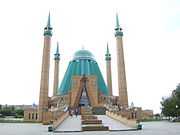
Tengri Bögü Khan made the now extinct Manichaeism the state religion of Uyghur Khaganate in 763 and it was also popular in Karluks. It was gradually replaced by the Mahayana Buddhism.[87] It existed in the Buddhist Uyghur Gaochang up to the 12th century.[88]
Tibetan Buddhism, or Vajrayana was the main religion after Manichaeism.[89][90][91] They worshipped Täŋri Täŋrisi Burxan,[92] Quanšï Im Pusar[93] and Maitri Burxan.[94] Turkic Muslim conquest in the Indian subcontinent and west Xinjiang attributed with a rapid and almost total disappearance of it and other religions in North India and Central Asia. The Sari Uygurs "Yellow Yughurs" of Western China, as well as the Tuvans of Russia are the only remaining Buddhist Turkic peoples.
The Krymchaks of Eastern Europe (Especially Crimea) are Jewish, and there are Turks of Jewish backgrounds who live in major cities such as Istanbul, Ankara and Baku. The Khazars widely practiced Judaism before their conversion to Islam.[citation needed]
Even though many Turkic peoples became Muslims under the influence of Sufis, often of Shī‘ah persuasion, most Turkic people today are Sunni Muslims, although a significant number in Turkey are Alevis. Alevi Turks, who were once primarily dwelling in eastern Anatolia, are today concentrated in major urban centers in western Turkey with the increased urbanism.
The major Christian-Turkic peoples are the Chuvash of Chuvashia and the Gagauz (Gökoğuz) of Moldova. The traditional religion of the Chuvash of Russia, while containing many ancient Turkic concepts, also shares some elements with Zoroastrianism, Khazar Judaism, and Islam. The Chuvash converted to Eastern Orthodox Christianity for the most part in the second half of the 19th century. As a result, festivals and rites were made to coincide with Orthodox feasts, and Christian rites replaced their traditional counterparts. A minority of the Chuvash still profess their traditional faith.[95] Church of the East was popular among Turks such as the Naimans.[96] It even revived in Gaochang and expanded in Xinjiang in the Yuan dynasty period.[97][98][99] It disappeared after its collapse.[100][101]
Gallery
Modern times
-
Azerbaijani girls in traditional dress.
-

Young and old Gagauz people.
-

Hungarian folk Costume in Transylvania, Romania
-

Turkmen girl in national dress.
-
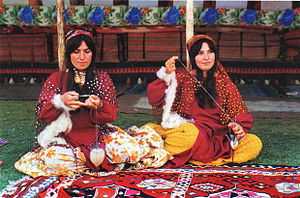
Qashqai women spinning.
-

Turkish women playing backgammon.
-

Bashkir boys in national dress.
-

A Chuvash woman in traditional dress.
-

A female Chuvash dancer in traditional dress.
-

Tatar woman in 18th century.
-

An Azerbaijani Female from Baku.
-

Karachay patriarchs in the 19th century
-

Altay man in national suit on horse
-

Kazakh family inside a Yurt
Medieval times
-

Khan Omurtag of Bulgaria, from the Chronicle of John Skylitzes.
-
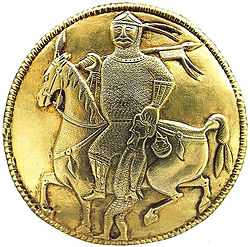
Khazar warrior with prisoner.
-
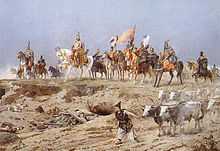
Prince Árpád crossing the Carpathians
Notes and references
- ↑ Brigitte Moser, Michael Wilhelm Weithmann, Landeskunde Türkei: Geschichte, Gesellschaft und Kultur, Buske Publishing, 2008, p.173
- ↑ Deutsches Orient-Institut, Orient, Vol. 41, Alfred Röper Publushing, 2000, p.611
- ↑ , Milliyet, 22 March 2007. (Turkish)
- ↑ United States, CIA World Factbook.
- ↑ ru:Этно-языковой состав населения России
- ↑ https://www.cia.gov/library/publications/the-world-factbook/geos/tx.html#People CIA World Factbook Turkmenistan
- ↑ https://www.cia.gov/library/publications/the-world-factbook/geos/af.html
- ↑ http://m.stlamerican.com/reader_interaction/letters_to_the_editor/article_a906f9d6-4a8f-11e0-9d87-001cc4c03286.html
- ↑ "Results / General results of the census / National composition of population". All-Ukrainian Census, 2001. December 5, 2001. Retrieved 2007-08-05.
- ↑ 10.0 10.1 Turkic people, Encyclopædia Britannica, Online Academic Edition, 2010
- ↑ "Timur", The Columbia Encyclopedia, Sixth Edition, 2001–05, Columbia University Press.
- ↑ Encyclopædia Britannica article: Consolidation & expansion of the Indo-Timurids, Online Edition, 2007.
- ↑ 13.0 13.1 Kultegin's Memorial Complex, TÜRIK BITIG Khöshöö Tsaidam Monuments
- ↑ 14.0 14.1 Bilge Kagan's Memorial Complex, TÜRIK BITIG Khöshöö Tsaidam Monuments
- ↑ Tonyukuk's Memorial Complex, TÜRIK BITIG Bain Tsokto Monument
- ↑ 卷099 列傳第八十七突厥鐵勒- 新亞研究所- 典籍資料庫
- ↑ The Turkmen
- ↑ Peter B. Golden, Introduction to the History of the Turkic People, p.12
- ↑ Ibid., p.116
- ↑ German Archaeological Institute. Department Teheran, Archaeologische Mitteilungen aus Iran, Vol. 19, Dietrich Reimer, 1986, p.90
- ↑
- Golden, Peter B. "Some Thoughts on the Origins of the Turks and the Shaping of the Turkic Peoples". (2006) In: Contact and Exchange in the Ancient World. Ed. Victor H. Mair. University of Hawai'i Press..
- András Róna-Tas, Hungarians and Europe in the early Middle Ages: an introduction to early Hungarian history, Central European University Press, 1999,
- ↑ (Bŭlgarska akademii︠a︡ na naukite. Otdelenie za ezikoznanie/ izkustvoznanie/ literatura, Linguistique balkanique, Vol. 27-28, 1984, pp.17
- ↑ Murat Ocak, The Turks: Early ages, Yeni Türkiye, 2002
- ↑ Faruk Suümer, Oghuzes (Turkmens): History, Tribal organization, Sagas, Turkish World Research Foundation, 1992, p.16)
- ↑ American Heritage Dictionary (2000). "The American Heritage Dictionary of the English Language: Fourth Edition - "Turk"". bartleby.com. Retrieved 2006-12-07.
- ↑ 26.0 26.1 G. Moravcsik, "Byzantinoturcica" II, p. 236–39
- ↑ Jean-Paul Roux, "Historie des Turks – Deux mille ans du Pacifique á la Méditerranée". Librairie Arthème Fayard, 2000.
- ↑ Peter Zieme: The Old Turkish Empires in Mongolia. In: Genghis Khan and his heirs. The Empire of the Mongols. Special tape for Exhibition 2005/2006, p.64
- ↑ 29.0 29.1 Findley (2005), p. 29.
- ↑ 丁零—铁勒的西迁及其所建西域政权
- ↑ "Etienne de la Vaissiere", Encyclopædia Iranica article:Sogdian Trade, 1 December 2004.
- ↑ 32.0 32.1 32.2 32.3 32.4 32.5 Carter V. Findley, The Turks in World History, (Oxford University Press, October 2004) ISBN 0-19-517726-6
- ↑ Silk-Road:Xiongnu
- ↑ Yeni Türkiye
- ↑ The Rise of the Turkic People
- ↑ Early Turkish History at the Wayback Machine (archived October 27, 2009)
- ↑ "An outline of Turkish History until 1923."
- ↑ Lebedynsky (2006), p. 59.
- ↑ Beckwith (2009), pp. 72–73 and 404–405, nn. 51–52.
- ↑ Keyser-Tracqui C., Crubezy E., Ludes B. Nuclear and mitochondrial DNA analysis of a 2,000-year-old necropolis in the Egyin Gol Valley of Mongolia American Journal of Human Genetics 2003 August; 73(2): 247–260.
- ↑ Nancy Touchette Ancient DNA Tells Tales from the Grave "Skeletons from the most recent graves also contained DNA sequences similar to those in people from present-day Turkey. This supports other studies indicating that Turkic tribes originated at least in part in Mongolia at the end of the Xiongnu period."
- ↑ MA Li-qing On the new evidence on Xiongnu's writings. (Wanfang Data: Digital Periodicals, 2004)
- ↑ Paola Demattè Writing the Landscape: the Petroglyphs of Inner Mongolia and Ningxia Province (China). (Paper presented at the First International Conference of Eurasian Archaeology, University of Chicago, 3–4 May 2002.)
- ↑ N. Ishjatms, "Nomads In Eastern Central Asia", in the "History of civilizations of Central Asia", Volume 2, Fig 6, p. 166, UNESCO Publishing, 1996, ISBN 92-3-102846-4
- ↑ Chinese History – The Xiongnu
- ↑ G. Pulleyblank, "The Consonantal System of Old Chinese: Part II", Asia Major n.s. 9 (1963) 206–65
- ↑ The Origins of the Huns
- ↑ Otto J. Maenchen-Helfen. The World of the Huns: Studies in Their History and Culture. University of California Press, 1973
- ↑ Otto Maenchen-Helfen, Language of Huns
- ↑ Josh Burk, "The Middle East and Its Origins" p.45"
- ↑ Johnson, Mark "Turkic roots its origins" p.43
- ↑ Moses Parkson, "Ottoman Empire and its past life" p.98
- ↑ The Pechenegs at the Wayback Machine (archived October 27, 2009), Steven Lowe and Dmitriy V. Ryaboy
- ↑ 54.0 54.1 Encyclopædia Britannica Article:Mughal Dynasty
- ↑ Encyclopædia Britannica Article:Babur
- ↑ the Mughal dynasty
- ↑ When the Moguls Ruled India...
- ↑ Babur: Encyclopædia Britannica Article
- ↑ Tamara Sonn. A Brief History of Islam, Blackwell Publishing, 2004, p. 83, ISBN 1-4051-0900-9
- ↑ É. Á. Csató, B. Isaksson, C Jahani. Linguistic Convergence and Areal Diffusion: Case Studies from Iranian, Semitic and Turkic, Routledge, 2004, p. 228, ISBN 0-415-30804-6.
- ↑ "Peoples of Iran" Encyclopædia Iranica. RN Frye.
- ↑ Savory, Roger (2007). Iran Under the Safavids. Cambridge University Press. p. 213. ISBN 0-521-04251-8, ISBN 978-0-521-04251-2 Check
|isbn=value (help). "qizilbash normally spoke Azari brand of Turkish at court, as did the Safavid shahs themselves; lack of familiarity with the Persian language may have contributed to the decline from the pure classical standards of former times" - ↑ E. Yarshater, "Iran", . Encyclopædia Iranica. "The origins of the Safavids are clouded in obscurity. They may have been of Kurdish origin (see R. Savory, Iran Under the Safavids, 1980, p. 2; R. Matthee, "Safavid Dynasty" at iranica.com), but for all practical purposes they were Turkish-speaking and Turkified. "
- ↑ John L. Esposito, The Oxford History of Islam, Oxford University Press US, 1999. pp 364: "To support their legitimacy, the Safavid dynasty of Iran (1501-1732) devoted a cultural policy to estbalish their regime as the reconstruction of the historic Iranian monarchy. To the end, they commissioned elaborate copies of the Shahnameh, the Iranian national epic, such as this one made for Tahmasp in the 1520s."
- ↑ Ira Marvin Lapidus, A history of Islamic Societies, Cambridge University Press, 2002, 2nd edition. pg 445: To bolster the prestige of the state, the Safavid dynasty sponsered an Iran-Islamic style of culture concentrating on court poetry, painting, and monumental architecture that symbolized not only the Islamic credentials of the state but also the glory of the ancient Persian traditions."
- ↑ Helen Chapin Metz. Iran, a Country study. 1989. University of Michigan, p. 313.
- ↑ Emory C. Bogle. Islam: Origin and Belief. University of Texas Press. 1989, p. 145.
- ↑ Stanford Jay Shaw. History of the Ottoman Empire. Cambridge University Press. 1977, p. 77.
- ↑ Andrew J. Newman, Safavid Iran: Rebirth of a Persian Empire, IB Tauris (March 30, 2006).
- ↑ RM Savory, Safavids, Encyclopedia of Islam, 2nd ed.
- ↑ Cambridge History of Iran Volume 7, pp.2-4
- ↑ Foster, John (1939). The Church of the Tang Dynasty. Macmillan. p. 13.
- ↑ Turkic Language family tree entries provide the information on the Turkic-speaking populations and regions.
- ↑ 74.0 74.1 Katzner, Kenneth (March 2002). Languages of the World, Third Edition. Routledge, an imprint of Taylor & Francis Books Ltd. ISBN 978-0-415-25004-7.
- ↑ Across Central Asia, a New Bond Grows – Iron Curtain's Fall Has Spawned a Convergence for Descendants of Turkic Nomad Hordes
- ↑ Milliyet (in Turkish). 2008-06-06 http://www.milliyet.com.tr/default.aspx?aType=SonDakika&Kategori=yasam&ArticleID=873452&Date=07.06.2008&ver=16
|url=missing title (help). Retrieved 2008-06-07. - ↑ Substantial numbers (possibly several millions) of maghrebis of the former Ottoman colonies in North Africa are of Ottoman Turkish descent. Finnish Tatars
- ↑ The Karakalpak Gene Pool (Spencer Wells, 2001); and discussion and conclusions at www.karakalpak.com/genetics.html
- ↑ Turkic people, Encyclopædia Britannica, Online Edition, 2008
- ↑ Vasiliev D.D. Graphical fund of Turkic runiform writing monuments in Asian areal, М., 1983, p. 44
- ↑ 81.0 81.1 Gordon, Raymond G., Jr. (ed.) (2005). "Ethnologue: Languages of the World, Fifteenth edition. Language Family Trees – Altaic". Retrieved 2007-03-18.
- ↑ Georg, S., Michalove, P.A., Manaster Ramer, A., Sidwell, P.J.: "Telling general linguists about Altaic", Journal of Linguistics 35 (1999): 65–98 Online abstract and link to free pdf
- ↑ Turkic peoples, Encyclopædia Britannica, Online Academic Edition, 2008
- ↑ Language Family Trees: Altaic
- ↑ Altaic Language Family Tree Ethnologue report for Altaic.
- ↑ Ethnographic maps
- ↑ 论回鹘佛教与摩尼教的激荡
- ↑ 关于回鹘摩尼教史的几个问题
- ↑ 藏传佛教对回鹘的影响
- ↑ 元明时期的新疆藏传佛教
- ↑ 汉传佛教对回鹘的影响
- ↑ 回鹘文《陶师本生》及其特点
- ↑ 回鹘观音信仰考
- ↑ Maitreya Worship among the Uighurs
- ↑ Guide to Russia:Chuvash
- ↑ 景教艺术在西域之发现
- ↑ 高昌回鹘与环塔里木多元文化的融合
- ↑ 唐代中围景教与景教本部教会的关系
- ↑ 景教在西域的传播
- ↑ 吐鲁番回鹘人的宗教流变
- ↑ 7-11 世紀景教在陸上絲綢之路的傳播
- Golden, Peter B. "Some Thoughts on the Origins of the Turks and the Shaping of the Turkic Peoples". (2006) In: Contact and Exchange in the Ancient World. Ed. Victor H. Mair. University of Hawai'i Press. Pp. 136–157. ISBN 978-0-8248-2884-4; ISBN 0-8248-2884-4
Further reading and references
- Alpamysh, H.B. Paksoy: Central Asian Identity under Russian Rule (Hartford: AACAR, 1989)
- Amanjolov A.S., "History of тhe Ancient Turkic Script", Almaty, "Mektep", 2003, ISBN 9965-16-204-2
- Baichorov S.Ya., "Ancient Turkic runic monuments of the Europe", Stavropol, 1989 (In Russian)
- Baskakov, N.A. 1962, 1969. Introduction to the study of the Turkic languages. Moscow. (In Russian).
- Beckwith, Christopher I. (2009): Empires of the Silk Road: A History of Central Eurasia from the Bronze Age to the Present. Princeton: Princeton University Press. ISBN 978-0-691-13589-2.
- Boeschoten, Hendrik & Lars Johanson. 2006. Turkic languages in contact. Turcologica, Bd. 61. Wiesbaden: Harrassowitz. ISBN 3-447-05212-0.
- Chavannes, Édouard (1900): Documents sur les Tou-kiue (Turcs) occidentaux. Paris, Librairie d'Amérique et d'Orient. Reprint: Taipei. Cheng Wen Publishing Co. 1969.
- Clausen, Gerard. 1972. An etymological dictionary of pre-thirteenth-century Turkish. Oxford: Oxford University Press.
- Deny, Jean et al. 1959–1964. Philologiae Turcicae Fundamenta. Wiesbaden: Harrassowitz.
- Findley, Carter Vaughn. 2005. The Turks in World History. Oxford University Press. ISBN 0-19-516770-8; ISBN 0-19-517726-6 (pbk.)
- Golden, Peter B. An introduction to the history of the Turkic peoples: Ethnogenesis and state-formation in medieval and early modern Eurasia and the Middle East, (Otto Harrassowitz (Wiesbaden) 1992) ISBN 3-447-03274-X
- Heywood, Colin. The Turks (The Peoples of Europe), (Blackwell 2005), ISBN 978-0-631-15897-4.
- Hostler, Charles Warren. The Turks of Central Asia, (Greenwood Press, November 1993), ISBN 0-275-93931-6.
- Ishjatms N., "Nomads In Eastern Central Asia", in the "History of civilizations of Central Asia", Volume 2, UNESCO Publishing, 1996, ISBN 92-3-102846-4.
- Johanson, Lars & Éva Agnes Csató (ed.). 1998. The Turkic languages. London: Routledge. ISBN 0-415-08200-5.
- Johanson, Lars. 1998. "The history of Turkic." In: Johanson & Csató, pp. 81–125. Classification of Turkic languages
- Johanson, Lars. 1998. "Turkic languages." In: Encyclopædia Britannica. CD 98. Encyclopædia Britannica Online, 5 September. 2007. Turkic languages: Linguistic history.
- Kyzlasov I.L., "Runic Scripts of Eurasian Steppes", Moscow, Eastern Literature, 1994, ISBN 5-02-017741-5.
- Lebedynsky, Iaroslav. (2006). Les Saces: Les « Scythes » d'Asie, VIIIe siècle apr. J.-C. Editions Errance, Paris. ISBN 2-87772-337-2.
- Malov S.E., "Monuments of the ancient Turkic inscriptions. Texts and research", M.-L., 1951 (In Russian).
- Mukhamadiev A., "Turanian Writing", in "Problems Of Lingo-Ethno-History Of The Tatar People", Kazan, 1995, ISBN 5-201-08300 (Азгар Мухамадиев, "Туранская Письменность", "Проблемы лингвоэтноистории татарского народа", Казань, 1995. с.38), ISBN 5-201-08300, (in Russian)
- Menges, K. H. 1968. The Turkic languages and peoples: An introduction to Turkic studies. Wiesbaden: Harrassowitz.
- Öztopçu, Kurtuluş. 1996. Dictionary of the Turkic languages: English, Azerbaijani, Kazakh, Kyrgyz, Tatar, Turkish, Turkmen, Uighur, Uzbek. London: Routledge. ISBN 0-415-14198-2
- Samoilovich, A. N. 1922. Some additions to the classification of the Turkish languages. Petrograd.
- Schönig, Claus. 1997–1998. "A new attempt to classify the Turkic languages I-III." Turkic Languages 1:1.117–133, 1:2.262–277, 2:1.130–151.
- Vasiliev D.D. Graphical fund of Turkic runiform writing monuments in Asian areal. М., 1983, (In Russian)
- Vasiliev D.D. Corpus of Turkic runiform monuments in the basin of Enisei. М., 1983, (In Russian)
- Voegelin, C.F. & F.M. Voegelin. 1977. Classification and index of the World's languages. New York: Elsevier.
See also
- Chigils Turks
- Shato
- Pan-Turanism
- Pan-Turkism
- Turkic languages
- Turkic migrations
- Turkic states and empires
- Turko-Iranian
- Turko-Persian tradition
- Turko-Mongol
- Turkology
- List of ethnic groups
- European ethnic groups
- Peoples of the Caucasus
External links
| Wikimedia Commons has media related to Turkic peoples. |
- Turkic Republics, Regions, and Peoples: Resources – University of Michigan
- Encyclopædia Britannica 1911 Edition
- Ethnographic maps
- International Turcology and Turkish History Research Symposium
- Istanbul Kültür University
- Examples of traditional Turkish and Ottoman Clothing
- Türkçekent Orientaal's links for Turkish Language Learning
- Türkçestan Orientaal's links to Turkic languages
- Ural-Altaic-Sumerian Etymological Dictionary
- Crimean Tatar Internet Resources
New DNA Results
- "Probable ancestors of Hungarian ethnic groups: an admixture analysis"C. R. GUGLIELMINO1, A. DE SILVESTRI2 and J. BERES
- MtDNA and Y chromosome polymorphisms in Hungary: inferences from the Palaeolithic, Neolithic and Uralic influences on the modern Hungarian gene pool
- World History Study Guide: "Dastan Turkic" at BookRsgs.com
- The Altaic Epic
- Downloadable article: "Evidence that a West-East admixed population lived in the Tarim Basin as early as the early Bronze Age" Li et al. BMC Biology 2010, 8:15.




